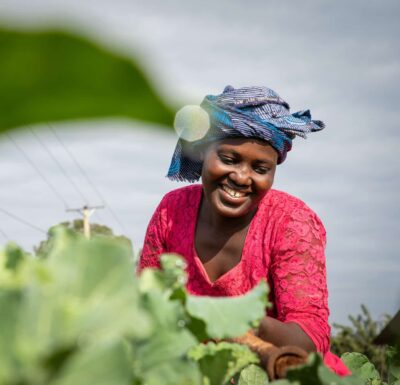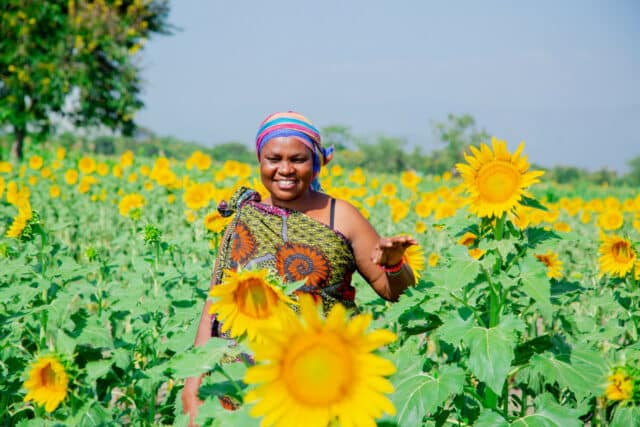Expert view
Ethiopia
12 May 2023
How an urban agriculture project in Ethiopia is improving lives and regreening communities

By Teshome Nega, Urban Agriculture Project Coordinator, Farm Africa
Urban low-income communities face immense challenges in accessing nutritious food. One of Africa’s biggest cities and Ethiopia’s capital, Addis Ababa, shares this struggle. A fifth of its five million residents live in poverty and now face high inflation and cost of living rates that make access to healthy food a daily challenge.
Fortunately, urban agriculture can help. Farm Africa’s urban agriculture pilot project in Addis Ababa has shown how cultivating food in a city can be a powerful and practical solution to poverty and hunger, while also creating the potential to enhance local ecosystems and green spaces.
With funding from Sida, the Swedish International Development Cooperation Agency, Farm Africa has been supporting low-income urban communities to grow their own produce and keep chickens and fish.
Most of the project participants were women who were eager to learn, bringing a sense of community spirit despite their limited experience in gardening or farming. Some were neighbours from nearby low-income communities. Others were low-paid government staff as the plot site was established on the Ministry of Planning and Development’s grounds.
Regreening the city

Photo: Gadissa Debeli Tessema
With tools, seeds and training provided by the project, the participants transformed previously neglected land into a productive green space that now provides a sustainable source of fresh produce. Well-designed and community-owned, the site is the first of its kind in Addis Ababa.
Vertical growing structures have been constructed to maximise the limited city space. The site has also become a learning destination for people interested in urban agriculture, including university groups.
But the real impact can be seen in the participants’ lives. The project focused on growing and consuming nutrient-dense and market-oriented vegetables, herbs and spices and providing access to markets – and the results have been impressive. The participants have grown a range of crops including cabbages, carrots, beetroot and lettuce, and have reared chickens and fish. In just one year, the programme has exceeded its target and participants have seen a 50 per cent increase in household incomes.
Women and young people have been particularly empowered thanks to a new savings and loan scheme. Members of the scheme have contributed money to the group’s savings fund, generating US $1,500. Some of this has come from the income generated from selling the project-grown produce to their local community.
The savings fund is then used to provide loans to members when they need access to finance, giving them the chance to pursue other profitable ventures and become more financially stable.
A savings and loan scheme is an effective and scalable way to empower women and young people in eastern Africa economically and socially as they often have limited access to formal financial services such as banks. They provide a safe and accessible way to save money, access credit and build financial literacy. They also give women and young people the chance to participate in decision-making, gain confidence and skills and create a sense of empowerment and autonomy.
Project participant, Abebech Hailemichael, commented, “The saving has a big contribution for us. For instance, I needed money for my personal business at home. I was able to fulfil my demand taking a loan and paying it back. That means a lot for me. It gives you confidence to have savings and loan access. That was not the case before. Currently, it’s different and wonderful!”
Improved nutrition
Yet, the benefits go beyond money. The year-round availability of leafy green vegetables and poultry products has also had a positive impact on nutrition and food security. Households were consuming an average variety of around four food groups a day. This has grown to more than seven. Household year-round access to sufficient food grew by 18 per cent, an important indicator of food security.
What’s more, the levels of heavy metals are much lower in the project’s vegetables compared with equivalent produce bought from the city’s markets. Urban agriculture shows that when a community grows its own food, they are empowered with the knowledge of exactly what they are eating.
Community spirit

Another promising aspect of the project is the impact it has had on the community. Many of the neighbouring participants have embraced urban agriculture and continued to practise it in their own gardens, growing vegetables in hanging pots and using other techniques they have learned.
Furthermore, it has been rewarding to see the community come together, forge new relationships and transform unused land into green, valuable spaces. They share their successes, challenges and advice; they have built a sense of unity that can sometimes be difficult to foster in large, busy cities.
Reflecting on the programme, participant Frehiwot Jima commented, “We have learnt many things, we are enthusiastic to see changes when we see our plants. There is a big difference between growing your vegetables and buying them from market. That feeds the whole family. We thank all those who designed the project and gathered us together.”
Growing up

Though people in cities can sometimes be disconnected from nature, urban agriculture can be done anywhere – gardens, community spaces, balconies, and even rooftops!
Even with a small amount of space, city dwellers can use vertical structures like green walls and climbing plants. Urban agriculture also offers the potential to transform abandoned areas not only into sources of food but income, too.
One participant noted, “Everything makes you happy: taking care of the plants, having them growing big and selling out, it gives you pleasure. Vegetables have good benefits for us. We are doing great. The income we have been earning supports our livelihoods. That means a lot for me.”
The pilot project has been a success for food security, enhancing the environment and reducing poverty, but Farm Africa wants to do more. With over half of the world’s population living in cities, this project can serve as a model for other urban areas facing similar challenges and inspire more people to take up urban agriculture.
By investing in urban agriculture, we can create resilient communities, improve access to healthy food, transform lives and regreen cities.
Find out more and donate to Farm Africa’s urban agriculture appeal here.




